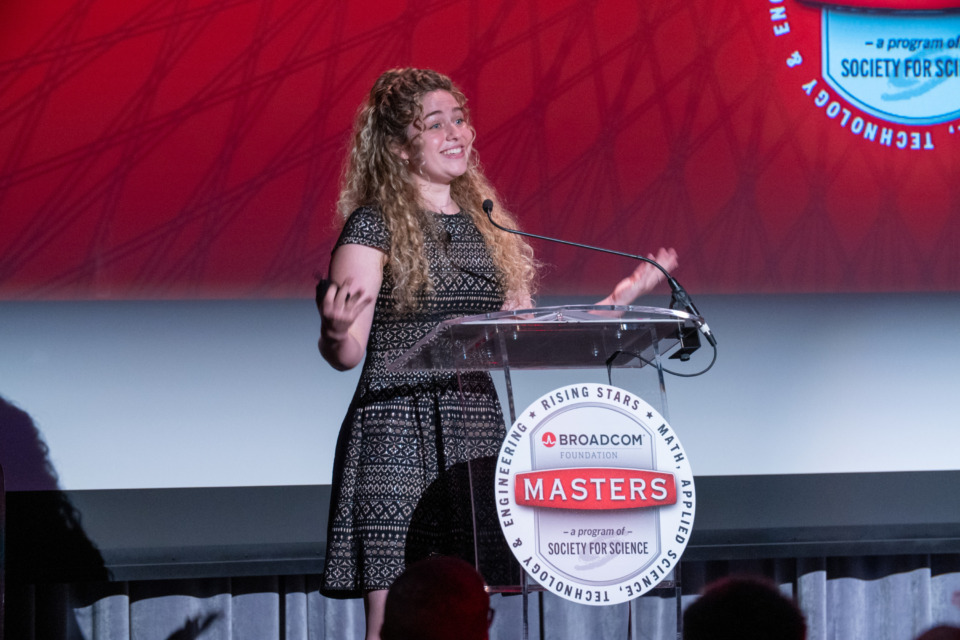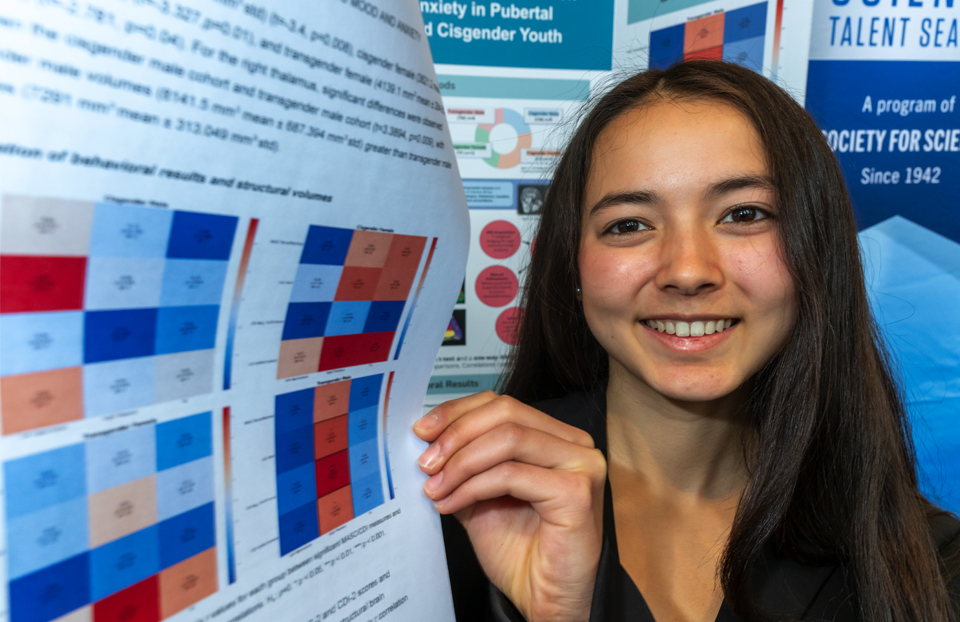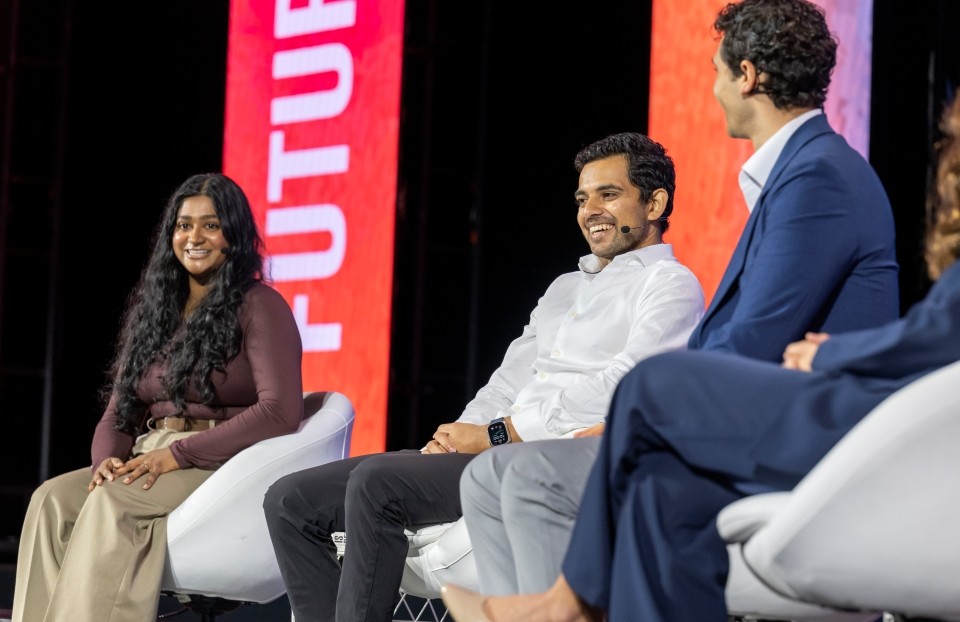Naomi Shah, Intel STS and Intel ISEF Finalist, Encourages Girls in STEM
Naomi Shah, Intel Science Talent Search (Intel STS) 2013 finalist, and most recently, Best of Category Winner in Environmental Science at the Intel International Science and Engineering Fair (Intel ISEF) 2013, recently had the opportunity to attend the ITU Tech Needs Girls conference in Brussels, Belgium.

Never would I have guessed that I would have the opportunity to present my research and my initiative to increase the number of girls participating in science, technology, engineering, and math (STEM) fields to the European Parliament. With Intel’s generous sponsorship, this trip turned out to be not only a fun adventure in the incredibly diverse and cultured country of Belgium but also an amazing learning opportunity, where I met international leaders and business representatives from many countries and heard how others are working toward similar goals of getting more girls involved in technology fields.
On the first day, we were so tired that we ended up dumping our bags in the hotel and crashing in an effort to sleep off the ever‐present jetlag. However, after futile attempts to fall asleep in broad daylight, we decided to explore the beautiful city of Brussels (and of course, to grab a bite to eat). We stayed near Luxembourg Square and had a nice traditional Belgian lunch. We had dinner with a group of international leaders in both politics and education and were able to delve into some of the most pressing issues facing girls in STEM fields in their respective countries. Later that night, we went out for Belgian waffles, of course!
The next morning, I attended the Technology symposium hosted by the European Union and learned to mix and create audio like a DJ. I had never done anything similar before, so it was a great experience and I was able to learn alongside the local Belgian students who were also attending the symposium.
We were bussed over to the European Parliament building and I changed quickly into more professional clothes, so that I was more presentable to international politicians and representatives. As we entered the room that Parliament gathered in, I realized how many countries were represented, because when I glanced around, it seemed that everyone was conversing in a different language. I enjoyed sharing what I had done and what I plan to do in the future to increase the number of girls in STEM fields. People were so interested in the FACT (Females Advancing Computing and Technology) camp that I started at Sunset High School for middle school girls, that it made me realize its’ true promise as a program that could even be rolled out nationally.
After the conference, we celebrated an amazing day of presentations, photos, networking, and “girls-in-tech” love with more traditional Belgian food! We were also able to drive to another city called Brugges the next day for some more authentic Belgian sight-seeing. We bought chocolate from Dumont’s and enjoyed roaming the small, cobblestone streets of the cute city! On the last day, my mom and I were able to get some sight-seeing in before we had to leave, so we visited the Atomium (science nerds!), which is a national monument in Brussels and loved taking pictures in the rain, being true Oregonians. We also visited the Mannekin Pis, which is another national symbol for Belgians.
Of course, I was repping my Intel STS jacket throughout the whole trip! In all seriousness though, I am so grateful to Intel for providing me with the opportunity to spread my views on girls in tech with powerful people at the European Parliament and to learn from these leaders, educators, and politicians on what they think the future holds for girls entering tech fields.
What was your experience competing at the Intel Science Talent Search like?
Intel STS is an incredible experience and I have been looking forward to it since I heard about it through science fair years ago. Being in Washington, DC with 39 other incredible high school students seemed intimidating at first. However, as soon as I met everyone in the E-Lounge at the St. Regis Hotel, I felt like a had found my people. The next week we all bonded over nerdy discussions about our research and our future plans for college and careers. We also managed to squeeze in movie nights, Dance Dance Revolution competitions, games of ninja, contact, and other bonding activities. While Intel STS is one of the most prestigious science competitions, the competition is not cut-throat but rather collaborative. We all enjoyed explaining science and math concepts to one another and discussing some of the questions that had stumped us during judging afterwards in the lounge. I can truly say that I made some lifelong friends during that week.
The judging experience was so different than anything I had encountered through years of science research previously. The questions they asked were either very open-ended or extremely specific and made us think outside of the box. In four 15-minute sessions, my brain was stretched in ways that I didn’t know was possible as I was asked to create technologies that didn’t exist, work through math problems on the spot, answer questions that I’ve never considered before, and force myself to see familiar concepts from angles that were outside my high school coursework and extensive research. At the end I felt humbled and inspired because what I realized is that it’s really about the thinking process and not necessarily about the answers.
While the finalists and judging process were the two most memorable parts of Intel STS, there were so many amazing perks to being a finalist. When we weren’t in the E-Lounge downstairs at the hotel, we were out and about taking night tours of the monuments, visiting museums, presenting our research to the public and distinguished guests at the National Geographic Museum, or shaking hands with the President of the United States! The gala awards ceremony had all of us in awe, and by the end, we couldn’t believe that Intel STS was already over. I’m still in touch with many fellow finalists, and will be for years to come!
How has doing original research and participating in events like the Intel STS affected you?
Doing original research and competing in science fairs like Intel ISEF and Intel STS for the past 7 years (I competed in my first Intel-sponsored science fair in 6th grade) has given me a platform that allows me to demonstrate my passion for and growth in my independent research. Each year, I return to these fairs with more knowledge and more research experience that allows me to answer the questions that I am curious about and that I am seeking answers to. I get to share my research with well-established researchers and scientists who judge, students from around the world who are engaged and interested, and the public who can benefit most from my environmental health research. As a high-school researcher, it’s not always easy to get people to see that your project can improve their quality of life – but through science fairs, I have gained confidence in myself as a researcher and believe that by dedicating myself to a question, I can make a difference!
Do you have any advice for other young students interested in science?
My advice for young students interested in science is to find something you’re interested in and ask questions that you can answer. At first, these questions can be really “small” and seemingly insignificant but as you delve deeper and deeper into a field, your questions will become more specific and more technical. For example, the question that I asked as a 6th grader is “What is causing my family’s allergies?” so I started doing research and stumbled across air quality as a trigger for allergies and asthma. My next question was “How do air filters impact air quality?” These baby steps 7 years ago helped me get to the level of research that I am doing today where I am studying from an interndisciplinary lens the impact of airborne pollutants like PM10 and Volatile Organic Compounds (VOC) on the lung health of asthmatic patients. Further, with my knowledge base, I am working on creating a solution to the problem by developing a novel VOC biofilter to metabolically breakdown chemical pollutants.
Rather than trying to fit yourself into a research lab (which is fine for gaining experience working with certain techniques or equipment), instead read research papers and figure out what you want to answer. Even though we might not have advanced degrees, we still have the ability to think and problem-solve like a researcher and learning how to approach problems using the scientific investigation process is the fun part of tackling each subsequent question that pops up during research.
What are your future plans?
My short-term plans involve continuing work on my independent research and attending Stanford University, where I hope to explore more environmental engineering research. I want to further my biofilter research, which is a solution that I am currently working on to metabolically remove Volatile Organic Compounds from indoor air streams. My long-term goals involve working at the boundary between engineering and environmental research, as well as the subsequent social implications that follow, such as national regulatory policy.


